Driving in Japan 2007
The Impossible Achieved - A Drive Round Japan
For 35 years I had a business connection with a firm in Japan, but I had never been there. At the age of 68 I thought I ought to go before it was too late. The idea was to combine the business visit with a holiday travelling around central Japan to see what the country was like.
As a motoring enthusiast my preferred format for the trip was to hire a car and drive around, staying at hotels as I went along. When I suggested this to the few people I knew who had spent any time in Japan the response varied from 'inadvisable' to 'impossible', this latter opinion coming from my business associates in Osaka. However, the two best guide books to the country both considered that self-drive car rental was a reasonable way to get around outside the heavily populated areas.
Although I had driven extensively in Europe and the USA over a period of 50 years I must admit that I had some reservations about the idea, as I had little knowledge of the country and no knowledge of the language at all.
I tried putting 'Driving in Japan' into YouTube and this produced many videos that people had made in their cars, and it was possible to get an idea of junction layouts, road markings, traffic lights, signs, etc that later proved to be very useful. Further investigation revealed that the Japanese Auto Federation has a book entitled 'Rule of the Road' in six languages, for foreign visitors intending to drive in Japan, but all efforts to obtain a copy in advance or during the trip failed.
From Google and Flickr on the internet more information about people's experiences was forthcoming, and I gradually built up a picture of the motoring scene.
The plan was to spend the first two days in Osaka and Kyoto using public transport, to see the sights and study the traffic when the occasion arose. On the third day (Monday) the intention was to collect the hire car and drive to my business associates' head office about 6 miles north of Osaka, and then set off on a week-long trip around central Japan. This would take in countryside, coast, mountains, some old towns and villages, and would be a total distance of about 1000 miles.
My advance planning was based on the Lonely Planet guide and Shobunsha's ROAD ATLAS JAPAN, which is the only large scale road atlas (approx. 4 miles to 1 inch) with place names in English as well as Japanese.
The Japanese drive on the left, and the general standard of driving appeared to be fairly similar to that in Britain. The main streets in Osaka and Kyoto are quite like those in our cities, but side roads are generally narrower. Road signs, 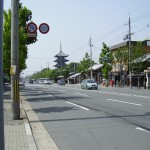 while not conforming to European standards, are mostly easy to understand and directionsigns on main routes have the main place names in English as well as Japanese, together with road numbers. At 'give way' junctions there are signs and Japanese words on the road which I had seen on YouTube, and these were always the same and quite easy to
while not conforming to European standards, are mostly easy to understand and directionsigns on main routes have the main place names in English as well as Japanese, together with road numbers. At 'give way' junctions there are signs and Japanese words on the road which I had seen on YouTube, and these were always the same and quite easy to 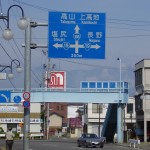 memorise. Major junctions have traffic lights suspended above the road on poles or gantries, and some of them had two amber lights, a system that I never fully understood. One came on after the other and appeared to be a progressive warning that the light was going to change to red, but people just kept going when the first one came on. Roundabouts are practically non-existent.
memorise. Major junctions have traffic lights suspended above the road on poles or gantries, and some of them had two amber lights, a system that I never fully understood. One came on after the other and appeared to be a progressive warning that the light was going to change to red, but people just kept going when the first one came on. Roundabouts are practically non-existent.
Many streets in Japanese towns don't have names and finding specific addresses is a nightmare for the local people let alone foreigners. Addresses are defined by chome (district), block number and building number. Buildings are often numbered in the order in which they were built, which is not very helpful if you have just got off a plane from England.
On the Monday morning I went to pick up my car, which I had booked with Europcar on the internet. Europcar's agent in Japan is Mazda Rentacar, a subsidiary of Mazda, and I had chosen a Mazda Axela, known here as the Mazda 3. The rental office in Shin Osaka was like a shop, with a Mazda 3 standing on the pavement in front. When I went in everyone smiled, and they indicated that I should sit down, and put a pile of papers in front of me. The top one said 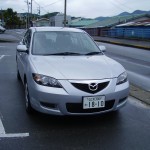 PLEASE READ THE CONDITIONS AND SIGN IF YOU AGREE, and the last sheet said FOLLOW ME. BRING YOUR LUGGAGE. When I was half way through a man who appeared to be the manager looked up, smiled, and said 'Car all Japanese'. Those were the only words of English spoken, and this was the moment that I realised how few people speak English outside the tourist hot spots. In due course a young lady took me out to the car, gave me the key and went back into the office.
PLEASE READ THE CONDITIONS AND SIGN IF YOU AGREE, and the last sheet said FOLLOW ME. BRING YOUR LUGGAGE. When I was half way through a man who appeared to be the manager looked up, smiled, and said 'Car all Japanese'. Those were the only words of English spoken, and this was the moment that I realised how few people speak English outside the tourist hot spots. In due course a young lady took me out to the car, gave me the key and went back into the office.
The car was automatic with air-conditioning and had a wonderful sat-nav system, which was really my salvation. It had a 6-inch screen and was an integral part of the car electronics. It was set in 2D (map) mode and all the place names were in Japanese, but the road numbers were very clear and it was easy to compare it with the 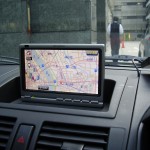 maps in the road atlas. I had no instructions for it, and dare not fiddle with it in case I lost the setting. The sound was turned off, which was just as well.
maps in the road atlas. I had no instructions for it, and dare not fiddle with it in case I lost the setting. The sound was turned off, which was just as well.
After setting up the car to suit my driving position I set off on the highways of Japan. From the car hire office to the industrial estate where my business associates were based was a straightforward journey of about 6 miles on a main road . At home I had studied the route on Google satellite maps, but there were certain things that I could not quite understand. It turned out that this was because it was an elevated road the whole way, with another road underneath, and in the event it was quite easy to find my destination.
Apparently in the 50 years that the Japanese company had been in existence I was the first foreign visitor to arrive driving a car, and this was a source of great interest and some concern, because a few people in the firm were still convinced that it was impossible. After the meeting and lunch Mr.Kitagawa, the President, and some of his henchmen came out to watch me drive away. They were obviously expecting me to crash before reaching the end of the road, a distance of about 50 yards.
On the way to my night stop in Kobe I encountered my first experience of unrealistic speed limits, mad motorcyclists and Japanese car parks.
Speed limits tend to be inconsistent, unrealistically low and are widely exceeded by a considerable margin. In Kobe I came across a stretch of dual carriageway with 3 lanes each way and few junctions. The speed limit? 40kph (25mph). The traffic was travelling at 40 to 45mph, which seemed a sensible safe speed. Town speed limits are generally 30, 40, or 50kph, but you come across long open stretches of road in the suburbs and even countryside with a 40kph limit. It is common for the traffic to be travelling at 50 - 60% higher than the limit, and there seems to be little effort put into enforcement. There are few cameras or traffic police cars. Other stretches of open road have an 80kph limit, and motorways (Expressways) usually 100kph. There is a minimum speed limit of 50kph on Expressways. Again, the actual speed of traffic on the motorway is about the same as in Britain. In April 2009 the Japanese government announced a wide-ranging review of speed limits to make them more realistic.
Also on the road in Kobe I learnt about mad Japanese motorcyclists. Many people commute by motorcycle on small or medium-sized machines, and they usually ride quite sensibly. The sports bike brigade, however, appear to be a law unto themselves. They fly about at high speed in towns, and you have to be prepared for a bike to come through from behind fast on either side at any time. If they think they can get through they will come through. At the other end of the spectrum are the youngsters who tear around in the evenings on strangely modified small bikes and scooters.
In Japanese towns of any size there is virtually no free parking, and in most places residents are not allowed to own a car unless they can park it off the road. Nevertheless I found that I could usually park reasonably close to where I wanted to be, but it was very expensive, equivalent to between £1 and £2 per hour at the present rate of exchange. 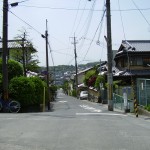 Many car parks have no instructions in English, and I just applied the principle of driving in and sorting out the exit arrangements when the time came. This could be quite challenging, and in one car park when I approached the barrier I was repeatedly shouted at in Japanese by a machine, until a passer-by came to the rescue and explained how the system worked. Many hotels, convenience stores and businesses have car parks for customers.
Many car parks have no instructions in English, and I just applied the principle of driving in and sorting out the exit arrangements when the time came. This could be quite challenging, and in one car park when I approached the barrier I was repeatedly shouted at in Japanese by a machine, until a passer-by came to the rescue and explained how the system worked. Many hotels, convenience stores and businesses have car parks for customers.
On the subject of shouting, in addition to a siren, fire engines have a loudspeaker on the front which shouts a message as they go along. Apparently it means "I am a fire engine, get out of my way".
As you go around you see a large number of people in uniform controlling traffic. Some are proper police who sometimes stand in the middle of junctions in the traditional manner that was abandoned in Britain years ago. Others are privately employed by businesses and organisations to regulate the traffic around their premises, but they do appear to have the authority to stop and direct vehicles on the road. As a foreigner I found it difficult to tell which were police and which were not, so I treated them all as if they were. On one occasion I was driving along a main road that apparently ran through the middle of a bus station. After giving way to a bus I started off again and heard a loud blast from a whistle. I then realised that there was a man in uniform on the other side of the road holding up the traffic, and I was on the receiving end of a scowl fearsome enough to ensure that I would never make the same mistake again. That was the only clash that I had with authority on the whole trip.
Once you are well away from population centres the scene changes completely, and as I drove northwards from Kobe 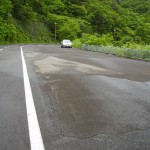 off the main routes there were times when there was no other traffic in sight. Minor roads are narrower than in Britain, and in many villages there are buildings jutting into the road at irregular intervals, so that you have to give way to approaching vehicles. Road works are quite common, usually with traffic lights, but after a couple of days I came across one which demonstrated the extraordinary difference in culture between Japan and the west. As I was driving along a twisty main road I came to sign which showed a short, wide, cartoon-like man wearing a hard hat and holding a flag. Sure enough, round the next bend there was a road works with a short wide man, wearing a hard hat and holding a flag. As I approached he waved the flag up and down. I stopped a few yards from him, and could not believe what happened next. He looked at me and bowed!
off the main routes there were times when there was no other traffic in sight. Minor roads are narrower than in Britain, and in many villages there are buildings jutting into the road at irregular intervals, so that you have to give way to approaching vehicles. Road works are quite common, usually with traffic lights, but after a couple of days I came across one which demonstrated the extraordinary difference in culture between Japan and the west. As I was driving along a twisty main road I came to sign which showed a short, wide, cartoon-like man wearing a hard hat and holding a flag. Sure enough, round the next bend there was a road works with a short wide man, wearing a hard hat and holding a flag. As I approached he waved the flag up and down. I stopped a few yards from him, and could not believe what happened next. He looked at me and bowed!
A feature of traffic lights at road works is that they have a display underneath which counts down the time in seconds until the light changes. When the red light is showing it is standard practice for Japanese drivers to wait until it gets down to about 8 seconds and then go. I was dreading being at the front of the queue and having to make the decision to go over the red light, but it didn't happen.
From the beginning I had resolved not to drive in the dark, but the Japanese will not have daylight-saving time, and it gets dark quite early even in May. I got caught out one evening when I had difficulty in finding a hotel, and finished up in the dark and rain in a town called Sabae City. The street lighting was very poor by our standards, and you need headlights to see where you are going a lot of the time, not just so that other people can see you. To make matters worse the only hotel I could find was a love hotel, but that is another story.
Very large numbers of people of people are employed in Japan in service jobs that disappeared 30 or 40 years ago here. Small filling stations are everywhere, with attended service, and I only saw one with self-service. To a great extent it is still a cash economy, and when a westerner pulls up at the pumps there are expressions of consternation by the staff, because they expect us to want to pay by credit card, and they cannot usually accept our cards. I found that the best answer to this was to jump out of the car, hold out my wallet showing sufficient cash to pay for the fuel, and shout 'Casha'. This would result in smiles all round and instant good service. Unlike the USA, tips are unknown for this type of service, and when I offered one young lad a tip he couldn’t understand what it was for.
Around 75% of Japan is mountainous, and after a few days I wanted to cross the mountains to visit some old towns and villages. There are few roads through the mountains, and according to the Shobunsha maps, most of those were likely to be closed under adverse weather conditions, which often means heavy rain as well as snow. I found this out the hard way, after visiting the wonderful Motorcar Museum of Japan at Komatsu. There were two possible routes to where I wanted to go, one a toll road more or less straight across the mountains, the other a much longer route via Kanazawa, which was likely to be a less pleasant drive with heavy traffic. I set off towards the toll road, and after about 20 miles there was a huge gantry over the road with a flashing red neon sign in Japanese. After another 25 miles of beautiful scenery I found out what it meant. There was a man in a toll booth in the middle of the road, and I held up my map, pointing at where I wanted to go. He tapped on the map at a point a few miles before the end of the toll road and said "NO! STOP!" I said "You mean I can't get through?". He tapped the map hard again and said "STOP!". It appeared that he did mean that I couldn't get through, and I had to go back about 30 miles and work my way to the longer route via Kanazawa. All in all I had driven about 70 miles out of the way on mountain roads, losing about 3 hours, although the scenery was worth it.
We think of the Japanese as being good at making small, intricate items like camcorders, but their civil engineering is 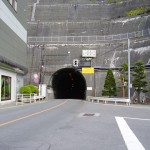 just as impressive. The country is covered with tunnels and bridges, and one day in the mountains I drove through tunnel after tunnel, some of them several miles long. One was particularly memorable. Normally the lights inside the tunnels are visible as you approach, but this one appeared to be a black hole in the mountainside. I was suspicious about this, which was just as well, because the road veered off to the left at 45º just inside the entrance, and what looked like a black hole was in fact a solid wall of rock. There might have been a sign or notice, but I did not see anything.
just as impressive. The country is covered with tunnels and bridges, and one day in the mountains I drove through tunnel after tunnel, some of them several miles long. One was particularly memorable. Normally the lights inside the tunnels are visible as you approach, but this one appeared to be a black hole in the mountainside. I was suspicious about this, which was just as well, because the road veered off to the left at 45º just inside the entrance, and what looked like a black hole was in fact a solid wall of rock. There might have been a sign or notice, but I did not see anything.
On a few occasions I resorted to using motorways (Expressways) to cover a lot of ground quickly. These are very good, but most are expensive, working out at about 25p a mile. Automatic and manual payment systems are used. A few are free.
There was only one moment of real motoring hell on the trip. Towards the end I was cutting across country to Nara, the ancient capital of Japan before Kyoto. There was no very direct route, and I was driving along a twisty main road in the mountains when I saw a hand-painted wooden sign on the right hand side pointing to the left, with NARA written on it. In retrospect I realised that I should have had more sense, but I turned off and the road went along a typical narrow village street. After the village it began to climb, and eventually turned into a series of hairpin bends. As I approached one right hand bend I saw a people carrier coming quite fast down the hill. It was obvious that we could not pass in the bend, so I stopped and reversed a few yards to where the road was wider. On the left hand side was a stone wall, and there was suddenly a lurch and a sickening crunch. The people carrier squeezed past and disappeared. I leapt out and ran round the back, thinking that I had hit the wall and imagining all the complications that there would be in the non-English speaking car hire office. In fact, I had not hit the wall, but the nearside rear wheel had dropped down into a concrete drainage gulley, designed to take the water away in heavy rain. The underside of the car was actually resting on the road.
So I was half way up a mountain in Japan, obstructing the road, mobile phone that would not work, unable to speak the language, at least a mile from the nearest habitation. I could see this developing into a major international incident. One way out was to throw myself over the wall and hurtle to my death on the rocks below, but I thought I would try something else first. I started the car, put it in first gear, and tried to pull away. It went, just as if it had been standing on all four wheels! At the top of hill I stopped and looked underneath, and apart from a few scrapings of concrete, there was no sign of damage.
On the way back to the Mazda Rentacar office I drove right through Osaka, and it was no worse than a similar large British city. The one-way systems demanded a lot of concentration, but with the sat-nav and a street map it was not too difficult. At Mazda there was yet another linguistic impasse over whether the petrol tank should be full or empty. This took about 15 minutes to resolve, and eventually the young lady came with me to a filling station nearby to top up the tank. The total distance I had driven was about 1600km (1000 miles).
At the earlier business meeting it had been arranged that Mr.Seto, the Head Chief of the Overseas Division, would meet me for dinner on my last evening. During the meal, which was rather more to my liking than the previous one, I realised that this was not just a friendly chat, but an interrogation to find out where I had been and how I got on. He said my trip had been the main talking point in the firm for the whole week, and some people were convinced that I would give up after a short distance.
Most foreigners who visit Japan do so on guided tours, and I did not see another westerner driving a car, although those who live there obviously do. One guide book I read beforehand said "Whether or not you decide to drive in Japan depends upon your personal adventure level". I would say it is not for the faint-hearted, but I found it a very enjoyable experience, if occasionally stressful.